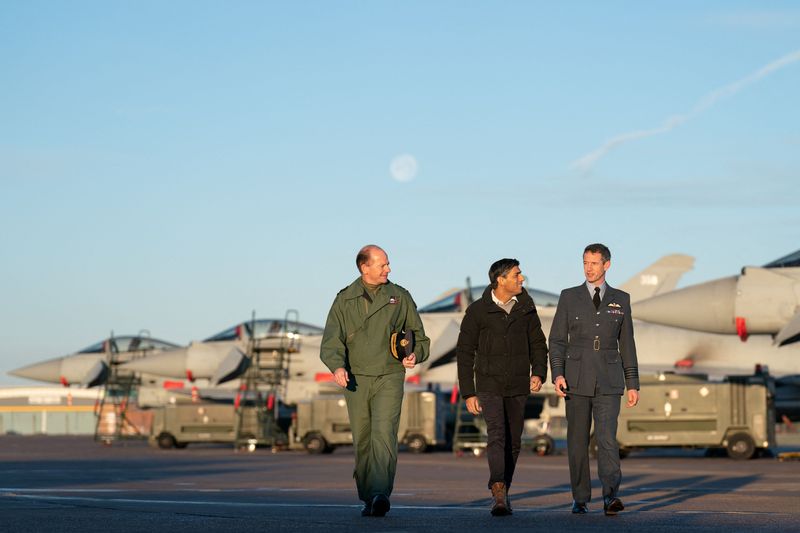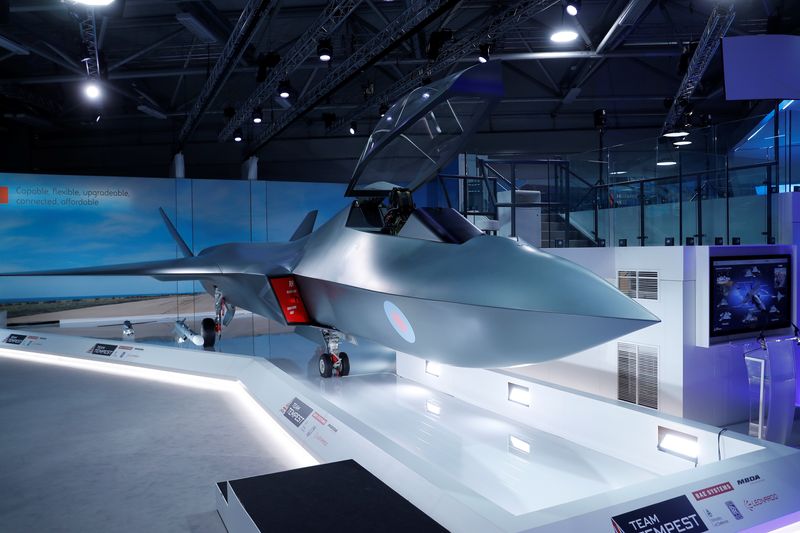By Tim Kelly, Paul Sandle and Nobuhiro Kubo
TOKYO/LONDON (Reuters) - Japan, Britain and Italy are merging their next-generation jet fighter projects in a bridge between Europe and Asia that marks Japan's first major industrial defence collaboration beyond the United States since World War Two.
The climax to months of talks reported by Reuters in July aims to put an advanced front-line fighter and pack of drones and sensors into operation by 2035 by combining the British-led Future Combat Air System, known as Tempest, with Japan's F-X in a venture called the Global Combat Air Programme (GCAP).
Against the backdrop of Russia's invasion of Ukraine and intensifying Chinese military activity around Japan and Taiwan, the agreement may help Japan counter the growing military might of its bigger neighbour and give Britain a bigger security role in a region that is a key driver of global economic growth.
"We are committed to upholding the rules-based, free and open international order, which is more important than ever at a time when these principles are contested, and threats and aggression are increasing," the three nations said in a joint statement on Friday.
Amid what it sees as deteriorating regional security, Japan this month will announce a military build-up plan expected to double defence spending to about 2% of gross domestic product over five years.
In Britain, Prime Minister Rishi Sunak said his country needed to stay at the cutting edge of defence technology.
"It means we can keep the country safe from the new threats that we face; it also adds billions to our economy and supports tens of thousands of jobs across the country," Sunak, visiting an air force base in eastern England, said.
Britain's BAE Systems (OTC:BAESF) PLC, Japan's Mitsubishi Heavy Industries and Italy's Leonardo will lead design of the combat air system, which will make use of artificial intelligence and be adapted to cyber warfare.
European missile maker MBDA will join the project, along with avionics manufacturer Mitsubishi Electric (OTC:MIELY) Corp.
Rolls-Royce (OTC:RYCEY) PLC, IHI Corp and Avio Aero will work on the engine, the Japanese defence ministry added.
The three countries have yet to work out some details of how the project will proceed, including work shares and where the development will take place.
Previous multi-national European defence projects have been distracted by sometimes bitter disputes over know-how and jobs.
Britain also wants Japan to improve how it provides security clearances to contractors, sources with knowledge of the discussions told Reuters.
The tie-up mirrors increasing convergence among Western planners over the strategic threat posed by China, which is steadily increasing availability its advanced Chengdu J-20.
"It reflects in the UK context an increasing importance or interest in the Indo-Pacific," said Paul O'Neill, director of military science at the RUSI thinktank.
'MANAGEMENT CHALLENGES'
Britain said other countries could join the project, which will replace its Eurofighter Typhoon warplanes and complement its U.S.-supplied Lockheed Martin F-35. It will be compatible with fighters flown by NATO partners.
BAE Chief Executive Charles Woodburn told reporters no other partners were needed.
"The three nations is everything that we need to take this programme forward very successfully," he said.
The novel tie-up with the Japanese will bring "interesting management challenges" for the UK, said RUSI's O'Neill, given the different cultures, creating the potential for slippage.
Delays have become a chronic part of big arms projects.
Confirmation of the plan comes days after companies in France, Germany and Spain secured the next phase of a rival initiative to build a next-generation fighter to enter operation from 2040.
That followed a squabble between France's Dassault Aviation and Airbus over leadership, which analysts said left France a central role in the core part of the project, which involves a fighter and cloud-connected drones.
Asked about the potential for the rival projects to join forces, Woodburn acknowledge it was a possibility.
"At the end of the day, these are political decisions," he said.
Others said the emergence of two competing groups of three nations left less room to move around the industrial pieces.
"Never say never. But that said, this does make a full consolidation seem much more difficult," said Douglas Barrie, Senior Fellow for Military Aerospace at UK think tank IISS.
The two new platforms would compete head-on with each other and the United States in the global fighter market.
"There is going to be a Battle Royal in the next 10-15 years in positioning the various players," said UK defence analyst Francis Tusa.
The United States, which has pledged to defend all three countries through NATO and a separate security pact with Japan, welcomed the new Europe-Japan agreement.

"The United States supports Japan's security and defence cooperation with like-minded allies and partners, including with the United Kingdom and Italy," the U.S. and Japanese defence departments said in a joint statement.
Japan had initially considered building its next fighter with help from U.S. defence contractor Lockheed Martin Corp (NYSE:LMT), which had proposed an aircraft that combined the F-22 airframe with the flight systems from the F-35 fighter.
